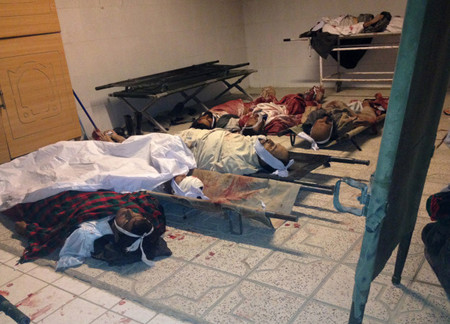There was a 22 percent rise in conflict-related deaths and injuries of Afghan civilians in 2014, says a new UN report.
The United Nations Assistance Mission in Afghanistan (UNAMA) says increased ground engagements between parties to the armed conflict in Afghanistan are behind the rise.
The 2014 Annual Report on Protection of Civilians in Armed Conflict, prepared in coordination with the Office of the United Nations High Commissioner for Human Rights, documented 10,548 civilian casualties in 2014, the highest number of civilian deaths and injuries recorded in a single year since 2009. Included in the toll were 3,699 civilian deaths (up 25 percent) and 6,849 civilian injuries (up 21 percent) for a 22 percent rise in total civilian casualties over 2013.
Since 2009, the armed conflict in Afghanistan has caused 47,745 civilian casualties with 17,774 Afghan civilians killed and 29,971 injured.
A press release says for the first time since 2009, more Afghan civilians were killed and injured in ground engagements than by improvised explosive devices (IEDs) or any other tactic. The report found that civilian deaths and injuries from ground operations surged by 54 percent making them the leading cause of civilian casualties and the biggest killers of Afghan women and children in 2014. Parties to the conflict increasingly used explosive weapons systems such as mortars, rockets and grenades, sometimes indiscriminately, in civilian-populated areas with devastating consequences for civilians. The increased indiscriminate use of IEDs and increased number of suicide attacks by anti-government elements added to the rising civilian casualties in 2014.
The UN Secretary-General’s Deputy Special Representative for Afghanistan, Nicholas Haysom has been quoted saying, “Rising civilian deaths and injuries in 2014 attests to a failure to fulfil commitments to protect Afghan civilians from harm.”
Worst offender
The UNAMA report highlighted that the government’s opponents remained responsible for the vast majority of Afghan civilian deaths and injuries. The report attributed 72 percent of all civilian casualties to armed anti-government forces, 14 percent to pro-government forces (12 percent to ANSF-Afghan National Security Forces, 2 percent to international military forces) and 10 percent to ground engagements between armed fighters and Afghan national security forces in which a civilian casualty could not be attributed to a specific party. Three percent of all civilian casualties were caused by unattributed explosive remnants of war with one per cent from cross-border shelling.
As the withdrawal of international military forces and combat air support continued in 2014, UNAMA observed more frequent and larger ground operations by both ANSF and anti-government fighters.
The report found that women and children were particularly hard hit by the armed conflict and increased ground engagements in 2014. UNAMA documented a 40 percent increase in children casualties with 2,474 children casualties (714 killed and 1,760 injured) compared to 2013. Women casualties increased by 21 percent with 298 women killed and 611 injured.
Women and children

Bodies of civilians are laid out a hospital after a suicide attack in the Yahyakhail district of Paktika province east of Kabul, Afghanistan, Sunday, Nov. 23, 2014. A suicide bomber attacked a volleyball tournament in eastern Afghanistan on Sunday, killing dozens of people, officials said. Dozens more were wounded when the bomber, who was on foot and mingling with the crowd, detonated his explosives, said Mokhlis Afghan, the spokesman for the governor of Paktika province. (Photo: AP)
To highlight the broader social and economic impact of the conflict on the lives of Afghan women, UNAMA interviewed 60 women from all regions in Afghanistan whose husbands, all civilians, were killed or seriously injured from conflict-related violence in 2014. UNAMA found that women who were left as sole income-providers for their households after the death or injury of their husbands often experienced long-term negative social and economic consequences, with poverty forcing many women to give their daughters in marriage in exchange for debts or to take their children out of school often to work. Widowed women were often particularly vulnerable to other forms of violence and abuse from family and community members.
“For Afghan women and children, the anguish of losing a husband and father in the conflict is often only the beginning of their suffering and hardship,” said the UNAMA Director of Human Rights, Georgette Gagnon in the press release. “The long-term social and economic consequences are devastating affecting the most vulnerable the hardest. After a year in which conflict-related violence led by ground engagements killed and injured record numbers of women and children, the destruction and damage to Afghan lives must be met with a new commitment by all parties to avoid harm to Afghan civilians.”
UNAMA said government forces continued to implement measures aimed at reducing civilian casualties in 2014. Despite these measures, UNAMA documented an increase in civilian casualties by mainly ANSF.
Rights abuse
UNAMA’s report noted a significant increase in human rights abuses committed against civilians by pro-Government armed groups in the north, northeast and southeast regions of Afghanistan, together with a widespread failure by the Government of Afghanistan to hold these armed groups accountable, and to protect affected civilians and communities.
In 2014, UNAMA documented increased incidents of anti-government elements, including the Taleban, punishing civilians for alleged infractions of Sharia law, perceived offences and allegations of spying. Incidents recorded included summary executions, beheadings, amputations of body parts, beatings, lashings and illegal detention.
“The appalling levels of violence in Afghanistan in 2014 should not be repeated in 2015,” said deputy special representative Haysom.



